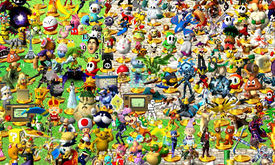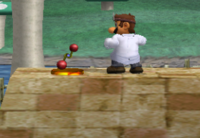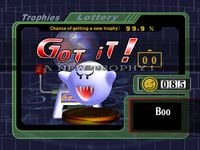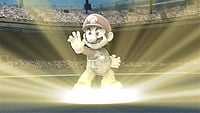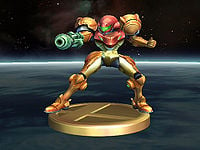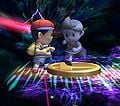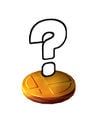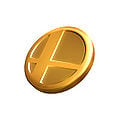Trophy: Difference between revisions
mNo edit summary |
|||
| Line 3: | Line 3: | ||
:''This article is about the collectible item. For the in-battle item, see [[Assist Trophy]].'' | :''This article is about the collectible item. For the in-battle item, see [[Assist Trophy]].'' | ||
:''For complete lists of trophies, see [[List of trophies]].'' | :''For complete lists of trophies, see [[List of trophies]].'' | ||
'''Trophies''' ({{ja|フィギュア}}, ''Figure'') are collectible items found in the ''Super Smash Bros. series'', starting from ''[[Super Smash Bros. Melee]]''. | |||
'''Trophies | |||
Trophies represent various characters, items, and other elements from the many games released by [[Nintendo]] (and, in ''Brawl'', from third-party franchises ''Metal Gear Solid'' and ''Sonic the Hedgehog''). They range from well-known to obscure, including some that were released in Japan only (or were not released until after the Smash Bros. game in question). Collecting them is optional, and does not affect the gameplay of the other modes (excluding the [[Birdo]] and [[Pidgit]] trophies, which unlock a multiplayer stage for ''[[Super Smash Bros. Melee]]''). | Trophies represent various characters, items, and other elements from the many games released by [[Nintendo]] (and, in ''Brawl'', from third-party franchises ''Metal Gear Solid'' and ''Sonic the Hedgehog''). They range from well-known to obscure, including some that were released in Japan only (or were not released until after the Smash Bros. game in question). Collecting them is optional, and does not affect the gameplay of the other modes (excluding the [[Birdo]] and [[Pidgit]] trophies, which unlock a multiplayer stage for ''[[Super Smash Bros. Melee]]''). | ||
Revision as of 06:36, December 10, 2014
- This article is about the collectible item. For the in-battle item, see Assist Trophy.
- For complete lists of trophies, see List of trophies.
Trophies (フィギュア, Figure) are collectible items found in the Super Smash Bros. series, starting from Super Smash Bros. Melee.
Trophies represent various characters, items, and other elements from the many games released by Nintendo (and, in Brawl, from third-party franchises Metal Gear Solid and Sonic the Hedgehog). They range from well-known to obscure, including some that were released in Japan only (or were not released until after the Smash Bros. game in question). Collecting them is optional, and does not affect the gameplay of the other modes (excluding the Birdo and Pidgit trophies, which unlock a multiplayer stage for Super Smash Bros. Melee).
In Super Smash Bros.
Trophies were not present in the original Super Smash Bros.. However, the game included biographies of the twelve playable characters, with the eight starter characters' biographies available from the start and the remaining four unlocked at the same time as those characters. Similar in presentation to trophies, the model of the character displays various attacks, animations and poses (though only the special move attacks are named). The model can also be rotated by holding Z and moving the Control Stick.
Characters are depicted as plush dolls rather than trophies in the game's 1P Game, as well as in the Opening sequence.
Kirby in his "doll" state on the Continue screen.
In Super Smash Bros. Melee
Trophies made their first appearance in Super Smash Bros. Melee. There are a total of 290 trophies obtainable through regular play in the NTSC and PAL versions, with three additional trophies only accessible with an Action Replay (see below).
From the main menu of SSBM, a Trophy option exists. From here, players can view collected trophies, or gamble to collect new ones.
- The Gallery option allows players to view collected trophies, one at a time. Flavor text describes the trophy, and what its abilities or uses were in its original game, or simply describes the game itself. A box at the bottom-right names the game and year it first appeared in; if the language is set to Japanese, then the system it appeared on first is also displayed. The trophy can be rotated and zoomed, and the background can be changed. When the Gallery is selected, it automatically views the last trophy viewed. If B is pressed after this, a list of collected trophies is shown, which can be arranged in the Normal setting, by Series or in Alphabetical Order. Newly-collected trophies that have not been viewed yet will have a "New!" banner beside them.
- The Trophy Lottery allows players to spend Coins, collected through normal gameplay, to collect new trophies.
- The Collection option allows players to see all the trophies that have been collected.
Collecting trophies
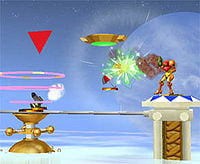
There are several methods in which to collect trophies:
- The player always receives a single random trophy when starting a new game file.
- The 1P Classic Mode contains a bonus stage called "Snag the Trophies". The goal of this mini-game is to knock three falling trophies into a goal in the center of the stage. Any collected trophies are added to the Gallery, and if all three trophies are collected, bonus points are awarded at the end of the game.
- During the Race to the Finish bonus stage, trophies can be found lying around.
- By completing Classic Mode, Adventure Mode or All-Star Mode with a certain character, players can gain trophies of that character. Each mode yields a unique trophy, resulting in 78 unique trophies for the 26 characters (Sheik's trophies are unlocked at the same time as Zelda's). Completing certain objectives or clearing the modes with specific conditions can also give specific trophies.
- In certain Adventure Mode stages, trophies can be found lying around the environment, or by defeating common enemies. These can be picked up like items, and are added to the player's collection.
- In All-Star Mode, trophies can be found after every few rounds.
- Trophies can be collected by completing Event Matches 3, 14, 26, 45 and 47 (Motion-Sensor Bomb, Goomba, Entei, Game & Watch, and Majora's Mask, respectively).
- The Trophy Lottery, as mentioned above, allows the player to collect random trophies in exchange for Coins.
- Completing special tasks within the game will award the player with trophies. For a complete list, see the List of trophies.
Changes between versions
- In the Japanese version, the Motion-Sensor Bomb was designed after the Proximity Mine from Perfect Dark. However, in the North American and PAL versions, the item's appearance and name were changed to the weapon from GoldenEye 007 (also used in the original Super Smash Bros.). Additionally, the mine's trophy lists "TOP SECRET" in the game slot. In the PAL version, the item is renamed the Proximity Mine.
- In the beta and japanese versions, the Topi trophy is replaced with a small seal. The seals appeared in the Japanese version of Ice Climber, but were changed to the yeti-like Topis for the US release, due to possible animal rights problems. This is reflected in Melee.
- The Tamagon trophy was removed from the NTSC/PAL versions due to its obvious religious references. The trophy exists in the NTSC version, and can be viewed with an Action Replay; it does not exist in the PAL version at all.
- The two "hidden" trophies, Samus Unmasked and Mario & Yoshi, can only be accessed by an Action Replay. Originally, they were given out at certain Japanese events, but no such event happened elsewhere.
- In the Japanese version, a Virtual Boy can be seen next to the vase with flowers in it; because of the console's failure in North America, it does not appear, though it can be seen if one changes the language to Japanese. Because the Virtual Boy was not released in Europe, it doesn't appear in that version either; it can never be seen, as the PAL version does not have the feature to change the language into Japanese.
- Melee Abandoned Continue 1.png
Yoshi's trophy when it came down onto the table on the Adventure Mode Continue screen. The announcer chooses to let the player continue or not in Continue.
Marth's Standard Smash trophy in the Gallery
In Super Smash Bros. Brawl
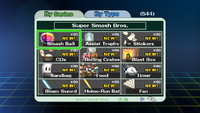
Trophies continue to appear in Super Smash Bros. Brawl. Conceptually, they are unaltered from Melee, but their number was nearly doubled to 544 trophies, with repeat trophies given new 3D models and text. Some unlockables in the game are also gained by collecting enough trophies.
More 'backstory' is provided to trophies in this game: in The Subspace Emissary, the storyline states that fighters who fall in this world in battle are forcibly reverted back to Trophies. These trophies of fallen smashers appear as greyed-out, shiny, full-size statues instead of the smaller trophies or statuettes seen in the Trophy Gallery.
In the Trophy Gallery, trophies can be sorted by series (universe), or by type, which has the following categories: Fighter, Fighter Related (most trophies originating from non-Smash universes), Final Smash, Item, Assist Trophy, Poké Ball, The Subspace Emissary, Enemy (Subspace Emissary enemies, bosses, and the Fighting Alloys), (stages and background characters), and Other (trophies from non-fighter universes, such as Animal Crossing, and other trophies).
As in the previous game, the trophies can be all collectively viewed at in the Trophy Hoard mode.
Collecting trophies
Trophies can be obtained through the following means:
- To obtain character trophies, players must finish Classic Mode with that character (one should note that if they play as characters that switch, i.e., Zelda/Sheik, Pokémon Trainer, and Zero Suit Samus/Samus, they only receive a trophy for the character they finished with, and not all characters, requiring more than one playthrough.)
- A trophy of Pokémon Trainer will always be obtained, no matter what character the player ends as, meaning that a player must obtain at least three Pokémon Trainer trophies to get the trophies of all three Pokémon.
- To obtain characters' Final Smash trophies, players must finish All-Star Mode with that character (again, Zelda/Sheik and Samus/Zero Suit Samus' trophies must be collected separately, although Pokémon Trainer's only has one Final Smash trophy to collect)
- Some trophies are only obtainable by beating a Challenge;
- Others, such as the Subspace Army boss trophies, can only be collected through the The Subspace Emissary by fighting an enemy and throwing a trophy stand at it when its hit points are critically low in order to capture it as a trophy.
- If the player manages to get a Celebi from a Poké Ball, it will drop some trophies. However, there is only a 1 in 493 chance of encountering Celebi this way.
- Again, in All-Star and Boss Battles modes, trophies will occasionally appear between rounds.
- Added from Melee, a few trophies lie on the Home-Run Contest track and will be automatically picked up by Sandbag if it is hit that far.
- The Trophy Lottery from Melee has been replaced by the Coin Launcher, through which most trophies not specifically limited above can be collected.
Diorama
This is a feature that is automatically incorporated into Brawl. Accessed from the Trophy Hoard, the player can pick any of the available backgrounds, and follow this up by choosing up to four of their trophies and positioning them against the background. Then, the player can use something similar to the photo menu found in Multiplayer Brawl to position the camera and take a picture, which can be saved to the Wii's internal memory or an SD card.
Gallery
Artwork of the Trophy Stand in Brawl.
In Super Smash Bros. 4
Collectible trophies appear in both versions of Super Smash Bros. 4. The Wii U version includes trophies based primarily on home-console games, while the 3DS version primarily focuses on trophies based on handheld games, with the trophy models varying as well.[1]
For the first time in the series, games that the trophy is based on are no longer listed below it in the 3DS version. On the Wii U version, up to two games are displayed, as well as the games(') system(s) (like SSB and Brawl), and the month and year of release are also stated (like in Melee).
With the reveal of a trophy depicting Ubisoft's Rayman in the Wii U version of Super Smash Bros. 4, the game marked the first time that third-party franchises without a playable character within the games could appear as trophies.
Random trophies can be obtained by defeating enemies during Smash Run in the 3DS version or by earning them during Smash Tour in the Wii U version. They can also be purchased via the Trophy shop. They may also appear in VS. battles, although this is rare. Super Smash Bros. for Nintendo 3DS alone features 685 trophies, while the Wii U version features 716 trophies.
While still informing players of the origin and details of trophies, the trophy descriptions in Smash 4 take on a considerably less serious tone than in either Melee or Brawl; trophies can feature puns, jokes, wordplay, references to popular culture, and descriptions that directly address the player.
A new feature exclusive to Super Smash Bros. for Wii U are Trophy Boxes for displaying collected trophies. These boxes are mostly themed after the source game(s) of what the trophy depicts.
Saria's trophy as it appears in Super Smash Bros. for 3DS.
A Little Mac trophy, based on his appearance in Captain Rainbow, as it appears in Super Smash Bros. for Wii U.
Trivia
- In hacking Super Smash Bros. Brawl, it has been discovered that some of the playable characters had different trophies that were meant to be their main trophy earned from beating Classic Mode with that character, but were taken out and replaced with the ones players see in the final version of the game. This could possibly mean that these were planned for the characters main artwork and CSPs were to be reminiscent. A video of the unused trophies can be seen here.
References
| Items in Super Smash Bros. Melee | |
|---|---|
| Normal | Barrel Cannon · Beam Sword · Bob-omb · Bunny Hood · Cloaking Device · Fan · Fire Flower · Flipper · Food · Freezie · Green Shell · Hammer · Heart Container · Home-Run Bat · Lip's Stick · Maxim Tomato · Metal Box · Motion-Sensor Bomb · Mr. Saturn · Parasol · Poison Mushroom · Poké Ball · Ray Gun · Red Shell · Screw Attack · Star Rod · Starman · Super Mushroom · Super Scope · Warp Star |
| Containers | Barrel · Capsule · Crate · Egg · Party Ball |
| Other | Smash Coins |
| Items in Super Smash Bros. Brawl | |
|---|---|
| Normal | Assist Trophy · Banana Peel · Beam Sword · Blast Box · Bob-omb · Bumper · Bunny Hood · Cracker Launcher · Deku Nut · Dragoon · Fan · Fire Flower · Food · Franklin Badge · Freezie · Golden Hammer · Gooey Bomb · Green Shell · Hammer · Heart Container · Home-Run Bat · Hothead · Lightning Bolt · Lip's Stick · Maxim Tomato · Metal Box · Motion-Sensor Bomb · Mr. Saturn · Pitfall · Poison Mushroom · Poké Ball · Ray Gun · Screw Attack · Smart Bomb · Smash Ball · Smoke Ball · Soccer Ball · Spring · Star Rod · Starman · Super Mushroom · Super Scope · Superspicy Curry · Team Healer · Timer · Unira · Warp Star |
| Containers | Barrel · Capsule · Crate · Party Ball · Sandbag · Rolling Crates |
| The Subspace Emissary |
Key · Stock Ball · Trophy Stand |
| Collectibles | CD · Coins · Sticker · Trophy |
| Other | Smash Coins and Bills |
| Super Smash Bros. Brawl menu items | |
|---|---|
| Group | Brawl (Time · Stock · Coin Battle · Team Battle) · Rules · Special Brawl · Rotation · Tourney · Names |
| Solo | Classic · All-Star · Adventure Mode: The Subspace Emissary · Events · Stadium (Target Smash!! · Home-Run Contest · Multi-Man Brawl · Boss Battles) · Training |
| Wi-Fi | Spectator Mode · With Anyone · With Friends |
| Vault | Trophies & Stickers (Trophy Gallery · Trophy Hoard · Coin Launcher · Sticker Album · Sticker Center) · Stage Builder · Album · Challenges · Replays · Masterpieces · Chronicle |
| Options | Screen · Deflicker · Rumble · Controls · Sound · My Music · Erase Data |
| Data | Movies · Records (Group Records · Brawl Records · Notices) · Sound Test |
